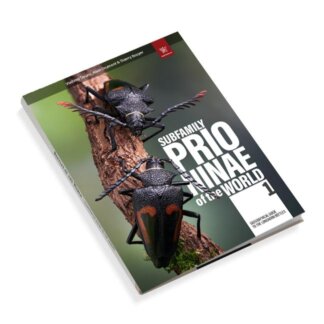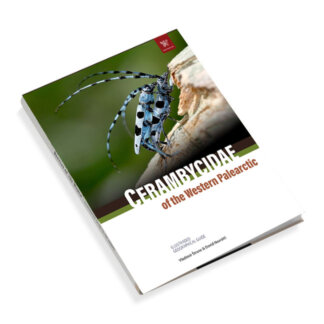The insect life cycle involves various stages of development, depending on the type of metamorphosis an insect undergoes. There are generally three types of metamorphosis: simple, incomplete, and complete.
Book novelties:
Prioninae of the World I.
Cerambycidae of the Western Paleartic I.
We recommend:
jeweled beetles, ground beetles, longhorn beetles, goliath beetle, stag beetle, carpet beetles
Books about Beetles
Unique pictorial atlases for identifying Beetles:
(2020) Tiger Beetles of the World, Cicindelidae, Illustrated guide to the genera
(2023) Tiger Beetles of Africa, Cicindelidae, Geographical guide to the family Cicindelidae
(2024) Tiger Beetles of Orient, Cicindelidae, Geographical guide to the family Cicindelidae
(2022) Ground Beetles of Africa, Afrotropical Region
(2022) Jewel Beetles of the World, Buprestidae, Illustrated guide to the Superfamily Buprestoidea
(2008) The Prionids of the World, Prioninae, Illustrated catalogue of the Beetles
(2010) The Prionids of the Neotropical region, Prioninae, Illustrated catalogue of the Beetles
Insect life cycle
Types of Metamorphosis
Simple Metamorphosis
This is the simplest form, often seen in primitive wingless insects like silverfish.
The young insect hatches from an egg and looks similar to its adult form but smaller.
It grows by molting (shedding its exoskeleton) several times until it reaches adulthood.
No distinct larval or pupal stages exist; the young consumes the same food as adults.
Incomplete Metamorphosis
Insects undergo three life stages: egg, nymph, and adult.
Nymphs resemble miniature adults without wings; they molt several times as they grow.
Wings develop externally during these molts and are fully formed at the final molt into adulthood.
Examples include grasshoppers and dragonflies.
Complete Metamorphosis
This involves four distinct stages: egg, larva, pupa, and adult.
Larvae (e.g., caterpillars) look very different from adults and often eat different foods.
After several instars (larval stages), larvae transform into a pupa where internal reorganization occurs to form an adult body.
Examples include butterflies, moths, beetles, ants, bees, wasps.
Common Stages Across All Types
Egg: The initial stage where development begins after fertilization or parthenogenesis in some species.
Immature Stage: Depending on the type of metamorphosis:
Nymphs for incomplete metamorphosis,
Larvae for complete metamorphosis,
Young resembling adults for simple metamorphosis.
Adult: The final stage capable of reproduction; growth ceases once this stage is reached.
Insects must molt periodically due to their rigid exoskeletons that cannot expand with growth. Each molt allows them to increase in size until reaching adulthood when no further molting occurs.

Insect Life Cycle: Understanding Metamorphosis and Development Stages
Insects, the most diverse and abundant group of animals on our planet, undergo remarkable transformations throughout their lives through a process called metamorphosis. This biological process involves distinct developmental stages as insects transform from immature forms to reproductive adults. The type and complexity of this transformation vary across insect species, with three main patterns of development observed: simple, incomplete, and complete metamorphosis. Each pattern represents different evolutionary adaptations that have allowed insects to thrive in virtually every terrestrial and freshwater habitat on Earth.
Fundamentals of Insect Metamorphosis
Metamorphosis is the biological process through which insects transform from an immature form to an adult form in distinct stages involving relatively abrupt changes to their body structure. These changes result from cell growth and cell differentiation. This transformation process is fundamental to insect development and has evolved as a successful strategy for resource allocation and ecological specialization.
All insects begin life as eggs, which may require fertilization by sperm to develop in many species. However, some insects like ants, bees, and wasps can produce female offspring without fertilization through a process called parthenogenesis. Throughout their life cycle, insects must periodically shed their exoskeleton or outer skin through a process called molting, which allows them to grow larger. Depending on the species, an insect may molt multiple times during its development.
The type of metamorphosis an insect undergoes is determined by its species and evolutionary history, with each pattern offering different advantages and adaptations to various ecological niches. These developmental patterns dictate the physical forms, behaviors, and ecological roles insects play throughout their lifespans.
Types of Insect Metamorphosis
Insects follow one of three basic growth and development patterns based on their species. Each pattern represents a different approach to development, with varying numbers of distinct life stages and degrees of transformation between immature and adult forms.
Simple Metamorphosis
The most primitive form of insect development is simple metamorphosis, which occurs in certain wingless insects such as silverfish. In this pattern, when eggs hatch, the resulting young insect appears almost identical to its adult counterpart, differing primarily in size. These young insects consume the same food and behave similarly to adults from birth.
As these insects grow, they periodically molt when their exoskeleton becomes too tight, shedding their old skin and emerging larger but essentially unchanged in form. After several molts and achieving full size, they reach sexual maturity and become capable of reproduction. Throughout their entire life cycle, these insects maintain essentially the same body form, with no dramatic transformation occurring between juvenile and adult stages.
Simple metamorphosis represents the most basic developmental pattern, with insects looking fundamentally the same from birth until adulthood. This strategy is successful for these primitive insect groups but has limitations in terms of ecological specialization compared to more complex metamorphosis types.
Incomplete Metamorphosis (Hemimetabolism)
Incomplete metamorphosis, also known as hemimetabolism, occurs in approximately 10-15% of insect species and involves three distinct stages: egg, nymph, and adult. When they hatch from the egg, the resulting immature insects, called nymphs, already resemble adults in basic form and structure, though they typically lack wings and reproductive organs.
Nymphs are generally as mobile as adults and often inhabit the same environments, though some species like dragonflies and mayflies show more pronounced differences between nymphs and adults. In these aquatic species, nymphs live in water and breathe using gills, while adults live in air and breathe using tracheas. Nymphs may consume either the same diet as adults or a different one, depending on the species.
As nymphs grow, they undergo a series of molts, shedding their exoskeleton when it becomes too tight. With each molt, they grow larger, and in winged species, wing buds gradually develop and increase in size. After several nymphal instars (stages between molts), the insect undergoes its final molt to become a fully formed adult, also called an imago, with functional wings and developed reproductive organs.
Insects that undergo incomplete metamorphosis include true bugs, grasshoppers, cockroaches, termites, praying mantises, crickets, and lice. These insects show a gradual development pattern, with each stage building incrementally toward the adult form without a dramatic reorganization of body structure.
Complete Metamorphosis (Holometabolism)
Complete metamorphosis, or holometabolism, is the most complex developmental pattern and occurs in approximately 85-90% of all insect species. This pattern involves four distinct stages: egg, larva, pupa, and adult. This developmental strategy allows for a complete reorganization of body structure between the feeding, growing larval stage and the reproductive adult stage.
The process begins when female insects lay eggs on or near appropriate food sources for their offspring. When the eggs hatch, they produce larvae, which often bear no resemblance to the adult form. Larvae focus primarily on feeding and growing, often consuming large amounts of food that may differ completely from the adult diet. Larvae may feed on plants, other insects, or organic matter, depending on the species.
After a period of growth and several molts, the larva enters the pupal stage, during which the insect undergoes a dramatic transformation. During pupation, the insect is typically dormant and does not feed, while internally, tissues break down and reorganize to form the adult body structure. This complete rebuilding of body form allows for specialized adaptations in both larval and adult stages.
Finally, the adult emerges from the pupal case with a completely different appearance from its larval form. The adult stage is focused on reproduction and dispersal, with adults feeding on nectar, pollen, or other food sources, or in some cases not feeding at all. Examples of insects with complete metamorphosis include butterflies, moths, bees, wasps, ants, and beetles such as ladybugs.
Molting and Growth Processes
Molting is a critical process in insect development that allows these animals to grow despite their rigid exoskeletons. Since the exoskeleton cannot expand, insects must periodically shed it and form a new, larger one to accommodate their increasing size. This process is essential for all insects regardless of their metamorphosis type.
The molting process begins when hormonal signals trigger the insect’s epidermis (skin) to separate from the old exoskeleton and secrete a new one underneath. Once the new exoskeleton is formed but still soft, the insect splits the old exoskeleton and emerges. The new exoskeleton then expands and hardens, providing the insect with more room to grow.
In insects with incomplete metamorphosis, successive molts gradually develop features like wing pads, which become progressively larger until the final adult molt when fully functional wings form. For insects with complete metamorphosis, molting takes on added significance during the transition from larva to pupa and from pupa to adult, when dramatic reorganization of body tissues occurs.
The juvenile stages between molts are called instars, and depending on the species, insects may go through three to more than thirty instars before reaching adulthood. Each instar represents a developmental stage where the insect grows larger and potentially develops new features.
Special Cases in Insect Development
While the three main patterns of metamorphosis cover most insects, some species exhibit unique variations or special developmental features. These adaptations represent evolutionary responses to specific ecological challenges or opportunities.
Mayflies present a particularly interesting case in insect development. After developing as aquatic nymphs, they emerge from the water and transform into a winged form called a subimago or pre-adult. This stage is unique among insects, as the subimago undergoes one additional molt a few hours later to reach true adulthood. This unusual additional stage may have evolved to help mayflies transition from aquatic to aerial life.
Aquatic insects such as dragonflies show another interesting adaptation, with their nymphs developing specialized structures for underwater living, including gills for respiration, while adults develop completely different respiratory systems for terrestrial life. This allows these insects to exploit both aquatic and terrestrial habitats at different life stages, reducing competition between juveniles and adults.
Some social insects like ants exhibit polymorphism, where individuals of the same species develop into distinctly different forms based on diet and environmental factors during development. This results in different castes (workers, soldiers, reproductives) with specialized roles in the colony, despite sharing the same genetic background.
Insect life cycle
The insect life cycle represents one of the most successful evolutionary adaptations in the animal kingdom. Through various forms of metamorphosis, insects have developed strategies to exploit different ecological niches, avoid competition between juveniles and adults, and maximize both growth and reproductive potential at different life stages.
Simple metamorphosis, with its gradual development and minimal change, represents the ancestral condition in insects. Incomplete metamorphosis allows for more specialized juvenile forms while maintaining similarity to adults. Complete metamorphosis, the most evolutionarily advanced pattern, enables insects to effectively live two different lives—one optimized for feeding and growth, and another for reproduction and dispersal.
Understanding these developmental patterns is crucial not only for basic insect biology but also for applied fields such as agricultural pest management, disease vector control, and conservation. As insects continue to face threats from habitat loss, climate change, and pesticide use, knowledge of their life cycles becomes increasingly important for developing sustainable management strategies and conservation efforts.



